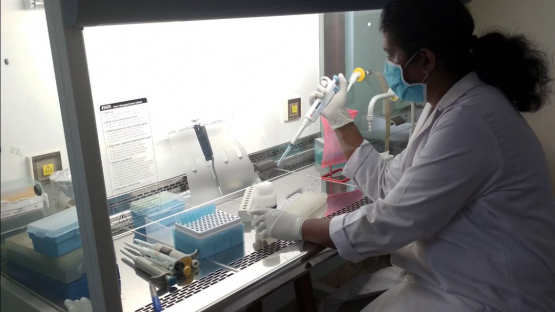In a joint effort to build up the nation’s defences, the IAEA and FAO helped establish the Centre at the University of Kelaniya in 2017. The University provided the space and other facilities, while WHO and Sri Lanka’s National Research Council and National Science Foundation provided funds to conduct research activities. The project involved allocating laboratory equipment and training nine staff members through fellowships and scientific visits. Additionally, the Centre has trained specialists working in vector-borne disease control programmes and partner institutions, with up to 100 trained thus far in national group activities supported by IAEA experts.
“The Centre has demonstrated that it has developed its capacity and expertise to conduct training, research and offer public services,” said Mykola Kurylchyk, Programme Management Officer at the IAEA and in charge of the Agency’s work in Sri Lanka.
One of the main objectives of the Centre is to conduct research on developing, testing and deploying innovative disease prevention techniques, such as SIT, and improving diagnostic testing. “The Centre has initiated over 18 research projects, and findings of these projects will definitely contribute to controlling vector-borne diseases in Sri Lanka and the Asia Pacific region,” Hapugoda said.
In feasibility studies, “researchers have demonstrated the potential of SIT by ionizing radiation as part of area-wide integrated pest management approach to suppress local dengue-vector mosquitoes,” said Wadaka Mamai, medical entomologist with the Joint FAO/IAEA Programme of Nuclear Techniques in Food and Agriculture. Field application of the technique is expected to be conducted in the near future and will also contribute to a regional project to suppress Aedes aegypti and Aedes albopictus mosquito vector populations.
“The successful engagement of the government, disease control programme managers and clinicians from the outset of the project has laid the foundation to sustain and move technology into the clinical setting,” Kurylchyk said. “Early, rapid and definitive diagnosis of vector-borne diseases will facilitate timely management of patients, which will also strengthen the country’s ability to control these diseases.”
The 740-square-metre Centre houses entomology laboratories, insectaries and an arthropod containment laboratory, where vectors of pathogenic agents are reared and maintained for research. By developing research capacity in entomology – the study of insects and their relationship to humans, the environment and other organisms – the Centre has become a focal point in the prevention and control of vector-borne diseases.
Furthermore, the Centre hosts training programmes in molecular biology, medical entomology and molecular entomology for staff within the country’s disease control programmes and government institutions. The Centre plays an active role in national surveillance systems and community-based disease control activities, while also providing public services, such as disease diagnosis and evaluation of vector-control devices.
Read more about the IAEA’s work to address infectious diseases.







